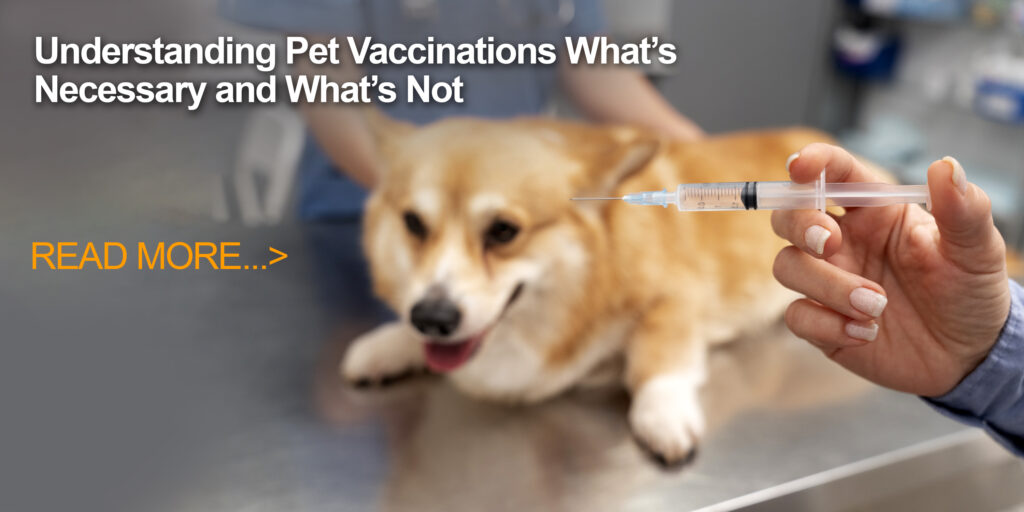Understanding Pet Vaccinations What’s Necessary and What’s Not
Understanding Pet Vaccinations What’s Necessary and What’s NotDiscover which pet vaccinations are essential and which ones are optional. One of the most important steps in doing so is through pet vaccinations. But with so many vaccines available, it’s natural to wonder: Which ones are truly necessary? And which ones might be optional?
In this guide, we’ll break down the types of pet vaccinations, their importance, and help you make the best health decisions for your dog or cat.
What Are Pet Vaccinations?
Vaccines work by stimulating your pet’s immune system to recognize and fight off specific diseases. These can include viruses, bacteria, and other infectious agents. Just like in humans, vaccines can prevent serious illness, reduce transmission, and in some cases, even save your pet’s life.
Types of Vaccines: Core vs. Non-Core
Veterinarians generally divide pet vaccinations into two categories:
1. Core Vaccines
These are essential for all pets, regardless of their lifestyle or location. They protect against severe and potentially deadly diseases.
- Dogs:
- Rabies
- Canine Distemper
- Canine Parvovirus
- Canine Adenovirus (Hepatitis)
- Cats:
- Rabies
- Feline Panleukopenia
- Feline Herpesvirus
- Feline Calicivirus
2. Non-Core Vaccines
These are optional and recommended based on your pet’s lifestyle, environment, or travel history.
- Dogs:
- Bordetella (Kennel Cough)
- Lyme Disease
- Leptospirosis
- Canine Influenza
- Cats:
- Feline Leukemia Virus (FeLV)
- Chlamydia
- Feline Immunodeficiency Virus (FIV)
Your vet can help determine which non-core vaccines make sense for your pet.
Rabies Vaccine: A Legal and Lifesaving Requirement
The rabies vaccine is not only vital for your pet’s health but also required by law in many regions. Rabies is a fatal virus that affects the brain and can be transmitted to humans through bites.
Most states and countries mandate rabies vaccinations, with booster shots every 1 to 3 years depending on local laws.
Why Core Vaccines Are Critical
Core vaccines protect against diseases that are:
- Highly contagious
- Often fatal
- Widespread in the environment
For example, Parvovirus in dogs and Panleukopenia in cats can kill quickly, especially in unvaccinated animals. Vaccinating early in life and keeping up with boosters is key to keeping your pet safe.
When to Vaccinate Your Pet: A Basic Schedule
Puppy and Kitten Vaccine Schedule:
| Age | Vaccine Type |
|---|---|
| 6-8 weeks | First core vaccines |
| 10-12 weeks | Booster shots |
| 14-16 weeks | Final puppy/kitten boosters |
| 1 year | Rabies and core booster |
| Every 1-3 years | Booster shots based on vet recommendation |
Note: Non-core vaccines may follow a different schedule.
Are Vaccines Safe for Pets?
Yes! Modern veterinary vaccines are highly safe and well-regulated. Mild side effects like fatigue, a low-grade fever, or slight swelling at the injection site are normal and usually go away within 24–48 hours.
Severe reactions are extremely rare. Always watch your pet after a vaccination and report anything unusual to your vet immediately.
Common Myths About Pet Vaccinations
Let’s bust a few common myths:
- Myth: “Indoor pets don’t need vaccines.”
Truth: Even indoor pets can be exposed to diseases through open windows, shoes, or other pets. - Myth: “Vaccines cause more harm than good.”
Truth: The benefits of vaccines far outweigh the risks. They prevent deadly diseases and keep your pet protected for life. - Myth: “Natural immunity is better.”
Truth: Some diseases are too severe to rely on natural exposure. Vaccines safely prepare the immune system.
Consult Your Vet: Every Pet Is Unique
Your pet’s health plan should be tailored. Always work closely with your veterinarian, who can assess:
- Breed
- Age
- Medical history
- Lifestyle (indoor vs. outdoor)
- Travel or boarding plans
This helps decide which non-core vaccines are necessary and how often boosters are needed.


